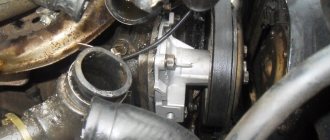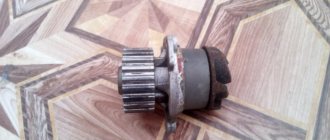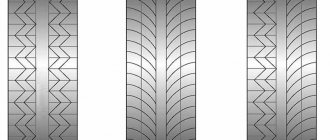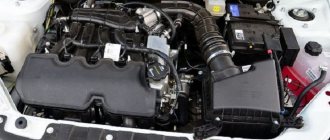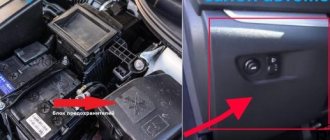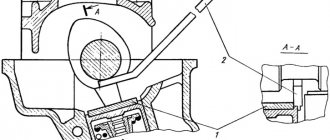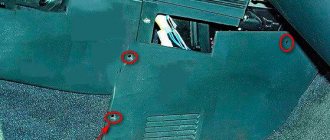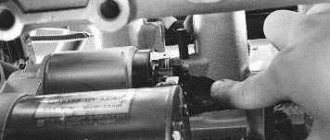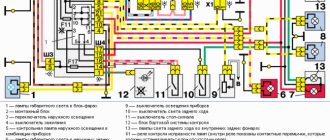How to change the license plate light bulb on Kalina
What tools will you need:
- flat screwdriver,
- a piece of rag
- new lamps.
The left side of the lampshade is made in such a way that you can place a thin object (in our case, a screwdriver) under it and pry it, releasing the first latch. This requires a little effort. If you are afraid of scratching the plastic, place a prepared rag under the tip of the screwdriver.
Once the left side of the latch has come out, move the lamp itself a little to the left and remove the right side. Pull the lantern out. Now you can either disconnect the wire, or simply turn the lamp a little and remove it from the housing.
The light bulbs in the license plate illumination are the most common ones - W5W. The same ones are in the front side lights. We take out the old incandescent lamps and insert new ones - LED ones. It’s better to immediately check whether you placed them on the wrong side; LED lamps have polarity! Well, now, with a clear conscience, everything can be put back together. The license plate light bulbs on Kalina have been replaced.
What advantages will we get after replacing the standard license plate light bulbs with LED ones?
- Firstly, they shine much brighter. This is noticeable even to the naked eye. And at the same time they consume much less energy, which leads to at least insignificant savings.
- Second, they don't get so hot. Having removed the old lamps, you may have noticed some melted plastic near their seats. It is not good. This definitely shouldn’t happen with diode lamps.
- And last but not least, it looks beautiful. Agree, the bright, white backlight of the license plate looks much better than the standard one.
How to change license plate lights
Wiring diagrams for Lada Kalina 2 hatchback (luxury).
electric Lada Kalina Lada Kalina Hatchback UltraViolet Logbook -062- How to drain antifreeze
Replacing the license plate light bulbs on the Lada Kalina is a simple task, so you can easily handle it yourself. By changing the lights yourself, you will not only save money on the services of workshop specialists, but you will also be confident in the excellent quality of the work.
Open the trunk of the car and pry the lamp on the left side with a flat-blade screwdriver. This will free him from the latch;
Step #1
Push the light on the right side and move it to the left. After some pressing, it should come out easily;
Step #2
Pull out the lamp along with the power wires. This will make it easier to replace the license plate lamps of the Lada Kalina;
Slightly lift the plastic clip up and remove the power plug;
Step #3
Carefully turn the white housing of the Lada Kalina license plate light bulb counterclockwise and completely pull out the base;
Step #4
Pull out the lamp itself. To do this, simply pull it to the side. After this, remove the lampshade from the base.
Step #5
Install a new lampshade in place of the burnt out bulb. The job is done in the same way as removing a light bulb, but in reverse order. Make sure the new light is lit.
Engine Cooling Water Pump
Personal experience of Renault Megane III
Here it is, a mine - a water pump. Refers to the cooling system, but is driven by a timing belt. If the pump wedges due to the death of the bearing, it will cut off the teeth on the belt, and then there will be destruction in the motor. And they “forgot” to mention this detail in the routine maintenance section of all service books. What to do with it? The consumer can only guess. Should we wait for death from natural wear and tear on a plug-in motor? Stupidity. And if changed, then when? It seems that the mine is not even the water pump itself, but the complete disregard for it in all the official VAZ “literature” for the consumer.
New VAZ engines are now equipped with high-quality timing belts from well-known brands. I believe that if no oil gets on it, it will cost 180 thousand. But is the difference in components really so great that on the 8-valve VAZ-11186 for Granta the belt must be changed at the 75th thousand, and on its closest relative VAZ-11189 at the 180th?
Let's continue the research. The pulleys are not demolished at all. Pressure roller bearing up to 180 thousand? Let's admit it, although it's hard to believe. But why change all this equipment at the 180th thousand, if the estimated life of the engine is 220 thousand km? Refresh before demise or major overhaul? If you don’t believe me, look at the photo taken in the workshops where VAZ engines are produced.
Engine valves VAZ-21116
After meeting the pistons, the valves were noticeably deformed (VAZ-21116 engine).
After meeting the pistons, the valves were noticeably deformed (VAZ-21116 engine).
The average consumer has access to only those that come with the car from official documents. What follows from them? Open the Grants service book. Replacing the timing belt - at 75 thousand kilometers for an 8-valve engine, not a word about the 16-valve belt! The same situation is with Kalina - I came across a book where there is nothing to say about one engine, but on the other we only check the condition of the belt, but there is no talk of a planned replacement. It’s even more fun with the Priora - there are service books where there is not a word at all about the gas distribution mechanism, but the air conditioning compressor belt is mentioned in almost every maintenance coupon.
With Vesta and Xray, progress is obvious - at 45, 75, 105, 135 and 165 thousand we adjust the gaps in the gas distribution mechanism. And for the first time we plan to remember the timing belt along with the rollers for 180 thousand kilometers! This is for 16-valve engines VAZ-21129, 21179 and 8-valve Vesta VAZ-11189. I can’t do without the quote: “2.11. Replace the timing belt along with the rollers. 2.12. Replace the crankshaft and camshaft sprockets. Replace the toothed belt, tensioner and support roller (for the VAZ-11189 8-cl. engine, only the tensioner) of the engine gas distribution mechanism drive. Adjust the tension of the toothed belt." Not only is the oil oil (we change the same belt twice), but of all the parts, they didn’t remember the most vulnerable one - the pump!
Replacing the pump on Lada Kalina 8 valves
Lada Kalina hatchback ultraviolet logbook -062- how to drain antifreeze
Personal experience Lada Priora hatchback On an 8-valve Kalina, you can change the water pump yourself. However, if the car owner does not have minimal experience in car maintenance, many questions may arise. For example, which pump to buy, how to choose the right tool, and is it worth draining the antifreeze from the system completely?
Which pump to choose
When the time comes to change the water pump, car owners begin to look at car dealerships for a worthy replacement. But which pump to choose so that it lasts as long as possible and does not cause problems for the owner?
In contrast, it will not last long - after 10 thousand kilometers the pump will need to be changed again.
At AVTOVAZ, designers install a TZA water pump on the Kalina. It has a long service life; drivers often change the pump only after 100 thousand kilometers. As an alternative, you can install more expensive German-made Bosch pumps - they are also famous for their quality and durability.
Where is the water pump located on Kalina?
Due to the fact that the pump is driven by the timing belt, it is part of the gas distribution mechanism. That is, you need to look for the water pump on the Lada Kalina from the side of the engine itself. Visually, before removing the belt, you can only see the pump pulley, which is involved in the gas distribution system.
The pump on the VAZ is located in the timing device
Preparing tools
It is recommended to prepare a standard set of tools for removing bolts and unscrewing nuts. You will also need a 6-point hex key. To drain the antifreeze without contamination and inconvenience, it is better to immediately find a container for draining and a rag to blot up any drops that have fallen on the engine elements. To ensure reliable installation of the pump, you can use a sealant with good thermal conductivity properties.
How much coolant to drain/fill when replacing the pump
In any case, before dismantling the old pump, you will need to drain the antifreeze from the system. This is necessary in order to reduce the pressure in the hoses and not be injured during sudden releases of liquid.
If the water pump has not been changed for a long time, then it is advisable to immediately drain the entire volume of antifreeze from the system and replace it with a new one. If the car owner has recently filled in new coolant, then there is no point in completely draining it: just disconnect the hoses from the expansion tank and wait until the antifreeze comes out.
To make it easier to fill a large volume of coolant, drivers usually use funnels
Operating procedure
First of all, you will need to install the machine on a flat surface. You can drive the Kalina into the inspection hole, you can simply lift the front right part on a jack. It is recommended to make sure that the car is securely secured; it is better to place additional supports under the body beam.
When dismantling the pump, you will need to remove the timing belts.
The work of replacing the pump on the Lada Kalina is carried out according to the following instructions:
- Remove the engine splash guard.
- Disconnect the negative terminal from the battery.
- Unscrew the cap from the expansion tank and immediately remove the plug located on the cylinder block. Wait until the coolant drains out.
- If all the antifreeze is drained, then unscrew the cap from the radiator and place a container under the drainage area.
- After the antifreeze has been drained, screw all the plugs back on.
- Remove the protective cover from the timing belt.
- Loosen the belt by slightly tightening the timing pulley.
- Remove the drive belt.
- Remove the four bolts that secure the pump pulley to the cylinder block.
- After removing the pulley, unscrew the last screws securing the pump.
- Pull the water pump out of its socket along with the gasket.
- Clean the planting site from adhering dirt and antifreeze drips.
- Apply heat-resistant sealant to the edges of the hole and install a new gasket on it.
- Place a new pump on the gasket and then proceed in the reverse order of removal.
Replacing a pump on an 8-valve Kalina
On a Kalina with an 8-valve engine, replacing the pump is not so difficult. But if a novice car enthusiast needs to do the work, he often has various questions. For example, what part to choose, what tool will be needed during work, what to do and in what order.
Which pump to choose for Kalina
When the time to replace the pump approaches or the part fails, many Kalina car owners are faced with the problem of choosing a pump. It’s clear that car owners want it to work for as long as possible. In order not to make a mistake, you need to consult with experts and read the reviews of other drivers. However, preference should be given to factory-made products.
When purchasing, pay special attention to the packaging: it must be of high quality, uncreased, with a gasket inserted inside, a warranty card, and a specified service life of the part. A high-quality product is packaged in a box with a holographic sticker. A TZA pump is installed, which has a fairly long service life.
You need to approach the choice of pump with all responsibility and not purchase a part from an unknown manufacturer.
The most preferred manufacturers of water pumps include:
It is quite difficult to answer unequivocally which manufacturer’s pump is better. Each detail has its own pros and cons. Which option to choose depends only on the owner. Pumps from VAZ-2108–09 and 21114 are also suitable for the 8-valve Kalina.
Video: review of water pumps for VAZ
Where is the pump located on Kalina?
On the Lada-Kalina car, the pump is driven by the timing belt and is part of the gas distribution mechanism. To carry out repair work, you need to look for the pump on the right side of the power unit. Without removing the timing belt, only the device pulley can be seen.
The water pump on the Lada Kalina is located on the right side of the engine
What tools will you need?
To replace the pump, you need a standard set of tools (wrenches, sockets), as well as a 6-point hexagon. It is necessary to select a suitable container and rags for draining the antifreeze in order to minimize engine contamination. Even though a new gasket is used when installing the part, for reliability it is recommended to use a sealant with high thermal conductivity.
To replace the pump you will need a standard set of tools that every car owner should have at their disposal: keys, sockets, screwdrivers
Preparatory activities
Preparing to remove the pump comes down to the following steps:
- It is necessary to remove the engine protective splash guard. It is secured with 10mm turnkey bolts.
- Remove the positive terminal from the battery, as well as the high-voltage wires from the ignition coil. The coil, so as not to interfere with free access to the antifreeze drain, is removed and put aside. To do this, use a 5 mm hex key to unscrew the coil bracket fasteners.
- Drain the coolant from the cylinder block into a prepared container by unscrewing the drain plug with a key to “13”, and also unscrew the expansion tank cap.
- If the antifreeze needs to be drained from the radiator, then move the container under the drain hole and unscrew the plug.
Work plan for replacing the Lada Kalina pump
Remove the timing belt protection cover. It is secured with 3 bolts - one on the left center, two on the back side.
Now we need to remove the camshaft gear, since it will prevent the removal of the iron protection that presses the pump itself. This is the peculiarity of the 8-valve Kalin engines.
Unscrew the nut securing the tension roller and loosen the belt as much as possible. Let's move on to the gear. When removing, do not lose the key; try to do everything so that the belt does not jump a couple of teeth from both the crankshaft gear and the timing gear. Otherwise, you will have to install both gears according to the marks, and this is problematic.
Having removed the timing gear, unscrew the bolts securing the protection - two in the middle and three at the bottom. The bottom 3 also hold the pump itself.
We take out the protection. Having picked up the pump a little with a screwdriver, we pull it out too. We clean the place where the pump is mounted on the engine from the remains of the old gasket and dirt.
We install the new pump in the reverse order. If desired, the gasket can be coated with sealant for greater reliability.
Timing belt
The timing belts that are now used on VAZ can survive more than one water pump, but it is better to replace the parts as a set.
The timing belts that are now used on VAZ can survive more than one water pump, but it is better to replace the parts as a set.
How would you act on your own without clear instructions in the service book? On both an 8-valve and a 16-valve engine, I would change at least the pump, and better yet, the belt and tensioner between the 60th and 70th thousand kilometers. According to the period, if the mileage is small, for the sixth year of operation.
Delayed action pump: what VAZ is keeping silent about
How to determine the performance of the pump?
To come to the conclusion that the pump needs to be replaced, you can conduct an inspection. It is very difficult to identify the presence of a malfunction in the pump without removing the belt. However, in practice there are some signs that make it possible to sufficiently identify the occurrence of deviations in the operation of the pump with the Lada Kalina engine running or turned off.
What does engine diagnostics include?
Among these symptoms are the following.
- The appearance of noise produced by the exhausted bearing of the Lada Kalina pump. Not every mechanic can identify this factor, not to mention an inexperienced car enthusiast. If you are “lucky enough” to detect noise, then there is a reason to inspect the gas distribution mechanism, located under the protective plastic cover. In this case, the pump needs to be replaced.
- The appearance of traces of antifreeze leakage. This may be indicated by a wet surface of the belt drive or pockets of moisture accumulating on the end surface of the motor unit. If the leak is quite intense, then over a short period of time a wet spot accumulates under a stationary car, and the level of antifreeze in the expansion tank gradually decreases. This phenomenon can occur due to wear of the oil seal present on the pump shaft.
- The belt is not located evenly on the camshaft drive gear, but rather offset from the center of its longitudinal axis. Its slippage can be caused by the appearance of play in the pump bearing.
Below are a few recommendations that will allow the owner of a Lada Kalina to facilitate the process of identifying pump faults. If one of the above factors is detected, then you should not be lazy and remove the belt from the camshaft gear. To do this, you will need to first loosen the tension on the belt drive by unscrewing the eccentric roller fasteners. Now it is enough to apply a manual rocking force to the pump shaft, which will reveal the play. When such a situation occurs, the water pump is immediately replaced. Even if there are no antifreeze leaks, further operation of the pump is prohibited, since a jammed bearing will cause the belt to break. Here we will not remind you about the risk of engine failure, because everyone already knows this.
A failed water pump on a Lada Kalina car can cause engine overheating, which in turn can cause irreparable damage to the cylinder-piston group. Some “advanced” owners resort to installing an additional pump, which is a very effective action in preventing the risk of airing the cooling circuit. As an additional pump, a part from the Gazelle is often used, the rotation of which is carried out by an independent electric motor. The component is cut into a pipe designed for the return flow of coolant, that is, into a small circulation circle. Power to the electric motor of this component is supplied through an additional relay, which is activated by a button located inside the cabin. This allows you to increase the mobility of the pump and turn it on at the right time.
Lada 2112 › Logbook › Preparing for winter Part 3. Installing an additional gazelle pump
Since the arrangement of the stove pipes according to the alternative scheme was not impressive, it became clear that there was no way without an additional pump. The last argument was the barely warm air from the stove at XX. And it’s already down to -15 outside...
When buying a cheap pump for 700 rubles, the first thing you need to do is unscrew 4 long screws and coat the rubber gasket with sealant. When I installed it for the first time without sealant, the pump leaked immediately. I needed a piece of hose 5 - 7 cm, an angled hose with a shoulder of about 10 cm, clamps and a wire of the required length.
There were big problems with choosing the installation location. Since I have a 4th generation gas pump installed and all the listed places for the pump were occupied either by the brains or by the gearbox. Even when connecting the heater alternatively, I hung the pump on the gearbox cushion, but it seems to me that due to the large difference, the heater didn’t work very well at XX either. And when returning to the stock circuit with a 6-hole thermostat, I took a closer look at the steering rack thermal screen. This turned out to be the only place where you can properly install the pump. The installation is simple, an angled pipe connects the outlet from the stove to the pump, and a small piece connects the outlet from the pump to the flute. The pump mount rotates in a circle as it should and rests on the screen, also secured with a clamp. Of course, such proximity to a spider will not add health to the pump, but we’ll see how long it lasts) I’ll connect the power to a button, but for now, if necessary, I’ll just throw wires on the battery. The result is good! Warm air begins to flow much earlier than before. As soon as it warms up in the XX, the air is hot, and in general Tashkent is moving) We look at the photos carefully and if you have questions, we ask. Hot stoves to everyone in winter!
source
Possibility of installing an additional water pump on the Lada Priora
One of the disadvantages of the heater on the Lada Priora car is its low efficiency when the engine operates at low speeds in the cold season, due to insufficient coolant circulation. Therefore, the car interior warms up slowly and insufficiently, which causes some discomfort for the driver and passengers.
There are some requirements that must be met to obtain a high-quality result after installing an additional electric pump.
These include the following points:
- the installed product should not create excess pressure in the heater radiator during operation in order to avoid damage to the pipes or the formation of cracks;
- It makes sense to replace the thermostat and install this component with an increased opening temperature (90–95 degrees Celsius) due to the fact that as the speed in the coolant circulation increases, the engine parts will warm up more slowly, increasing wear on the power unit.
To solve this problem, you can install an additional water pump in the cooling system of the power unit, which will qualitatively improve the heating of the car interior even when the engine is idling. This technology is not new. Engineers have been using it for a long time. Examples include German cars BMW or Mercedes Benz.
Device selection
As a rule, devices from various manufacturers are suitable as an additional water pump for the Lada-Priora car.
These, for example, could be brands from:
- Bosch company;
- ;
- .
Video: positive effect of installing an additional electric pump on the Lada Priora
However, most often the Lada Priora is equipped with an electric water pump, which is installed on Gazelle cars. This may be an old or new design, but the principle of operation is the same for both: due to the vacuum at the inlet during operation of the product, a pumping force arises, which drives the coolant through the system. In fact, the pump from the Gazelle car is a classic centrifugal pump.
The design of the new pump version is much more successful and causes fewer complaints from car enthusiasts. And it is also less noisy during operation. The main problem that motorists encounter when using such an electric pump is its leakage.
Installation and connection of an additional electric pump
To equip a car with an additional electric water pump, you will also need a regular relay that has normally open contacts (this can be an ignition or starter relay from a VAZ 2105, VAZ 2108). It is necessary to close contacts No. o86 and No. o30. And you will also need a reinforced hose and clamps for clamping the pipes.
An additional pump can be installed in any of the gaps in the supply or outlet pipes of the car’s heating stove.
Installation of an additional electric pump is quite simple, and the efficiency of the heater increases significantly
The pump is fixed in the Lada Priora in the following places:
- stud for fastening the washer reservoir;
- studs located next to the battery;
- on the engine shield.
The device can be connected to a wide variety of systems.
It could be:
- recirculation button;
- SAUO stove block;
- heated mirrors;
- other convenient places.
2. Installing a pump on the Lada Kalina engine
By visiting the plastic expansion tank, you can visually control the amount of antifreeze and antifreeze. There are special marks for the highest and lowest levels of liquids in the tank. Outside the tank, there is a pipe at the top for connecting to the heat exchanger sleeve, and at the bottom - with a filling tube.
Expansion cap with breathers. Device means inlet and outlet breathers. They are capable of providing systemic impermeability. Inlet valve
maintains elevated pressure in a hot engine. As the temperature increases, steam leakage decreases. The reduced pressure facilitates the opening of the released breather as the car engine cools evenly. The pump pumping antifreeze is a quick discharge blade. The crankshaft wheel drives the pump by means of a toothed belt on the camshaft rod. Its body consists of aluminum. The rotation of the shaft occurs in a double-row ball bearing, in which there is enough fuel oil for the period of warranty operation. The outer ring is tightened with a screw. A gear is pressed in front, an impeller, a retaining ring, and an oil seal are in the back. Antifreeze or antifreeze leakage is monitored through a hole in the pump shell. This method will help identify unit malfunctions. If the pump cannot be repaired, it is replaced with a similar assembly device. The redistribution of antifreeze is corrected by the coolant. Systemic cooling of paired cycles occurs as follows: in a larger circulation circle, the antifreeze seeps through the motor shell to the radiator battery; when moving in a small circle, antifreeze or antifreeze passes only through the cooling shell, without getting into the heat sink.
The cooling system consists of a radiator battery and a throttle heating unit. The circulation of antifreeze or antifreeze here occurs continuously, regardless of the location of the coolant valve.
Thermostat. The thermal unit and two breathers are components. There is a redistribution of the flow of antifreeze, also called antifreeze. When the engine is cool, the node valve redistributes the direction of water movement. It circulates along the smallest radius without entering the radiator. High temperatures of 85°C allow the valves to open and allow fluid to flow into the radiator. At temperatures above 100° C, the main valve is completely open, the spare valve is closed. Water circulation occurs over a larger radius. Antifreeze or antifreeze temperature meter. This device is screwed into the cylinder head for automatic antifreeze control. The sensor is connected to the temperature indicator on the machine's device panel. This information is sent to the controller. Heating heat sink. Built into the engine cooling system, it heats the car interior by circulating hot antifreeze. The radiator is a 3.2 plastic tank in a vertical position. Some of them have a partition. There are also 4 rows of round aluminum tubes, aligned horizontally, which are passed through cooling plates. The pipes are connected to the tanks through a rubber key. Antifreeze enters through the upper pipe and comes out through the lower pipe. The inlet pipe is located next to the narrow steam exhaust hose. The radiator has a casing with an electric motor. Drain plug at the bottom. The fan maintains the temperature inside the car. When the controller receives a signal, the fan is turned on by means of a relay.
Additional pump for Lada-Kalina
Some “Kalinovodov” are not satisfied with the standard heating of the cabin in winter. In order to somehow correct the situation and ensure the flow of hot air at idle, they resort to installing an additional pump. The part also provides better cooling in hot weather, especially when idling in traffic jams.
An additional pump avoids the formation of air in the system. As a rule, a pump from a Gazelle, which is structurally equipped with an electric motor, is used as such a device. Install it in the gap in the small circle of the cooling system on the return pipe of the stove.
An additional pump is installed in the gap in the return pipe of the stove to increase the efficiency of heating the interior in winter.
How to install an additional pump
For installation (in addition to the pump itself), you will need an additional relay and a button with which to control the device, hoses of different lengths, fasteners and sealant. You can choose any suitable place to secure the part. Quite often, car enthusiasts install a pump under the battery or under the transmission bolts. In the first case, the device is installed horizontally, in the second - vertically. Before installing the hoses, you must complete the following steps:
- Cut the hoses to the required length depending on the installation location and degrease them.
- Before installation, treat the mounting areas of the pipes with sealant.
- Secure the clamps evenly, slightly moving away from the edge of the hose.
- Drain the antifreeze.
- In the lower part of the engine compartment, find two pipes: one supplies coolant to the heater, the other takes it away. Remove the outlet hose and replace it with the pipe from the additional pump.
- Attach the pump to the gearbox housing. Mounting options may vary depending on available mounting hardware. These can be clamps or brackets.
Video: installation of an additional pump
When the additional pump is secured, you need to connect the switching wire. To avoid damage, it is placed in a plastic corrugation. To control the device, a button, a relay and a fuse are installed in the cabin in place of one of the plugs. When the button is turned on, the relay will be supplied with +12V from the battery. Then, by installing an additional pump, you can significantly increase the efficiency of the cooling system and achieve quick heating of the interior even in the most severe frosts.
An additional cooling pump is installed under the battery or under the transmission bolts
Replacing the pump on a Lada Kalina yourself does not cause any particular difficulties. Using a standard set of tools, you can repair your car yourself, avoiding trips to a car service center. For long-term operation of the pump, buy a product from trusted manufacturers, which will save not only your energy, but also money.
It is best to replace the pump on Kalina at the same time as replacing the timing belt, without waiting for it to leak and cause trouble. According to the manufacturer's recommendation, the belt is changed every 60 thousand km. This is a fairly long interval, during which time a new water pump will definitely pay for itself.
And the replacement procedure is quite within the capabilities of the average owner of a Lada Kalina car.
When to change your pump
It is interesting that in the documentation of many cars, including imported ones, there is no direct indication at what mileage to install a new cooling system pump. Therefore, you can act in two ways. The first is to carry out a scheduled replacement along with the timing belt, the second is to change the pump when it partially fails. However, the first option is more suitable, since it will keep the engine in working condition.
The service life of a car pump depends on the operating conditions of the car. In particular, the factors that lead to a reduction in this period are:
- engine operation in conditions of extreme temperatures (heat and excessive frost), as well as a sharp change in this temperature;
- poor-quality installation of the water pump itself;
- lack or, conversely, excess of lubricant in the pump bearings;
- use of low-quality antifreeze or antifreeze, corrosion of pump elements by coolants.
Accordingly, to extend the service life of this unit, it is necessary to monitor its condition and the condition of the engine cooling system.
Replacement frequency
As for the planned replacement of a car pump, the frequency of its replacement for many cars is simply not indicated in the technical documentation. Therefore, most car enthusiasts carry out a planned replacement every 60...90 thousand kilometers, which corresponds to a planned replacement of the timing belt. Accordingly, you can change them in pairs.
In the second case, if a higher quality pump and a lower quality belt are used, then the replacement can be carried out as follows - one pump replacement for two timing belt replacements (after approximately 120...180 thousand kilometers). However, it is necessary to carefully study the state of one and the other node. Along with replacing the strap and pump, it also makes sense to replace the guide rollers (if you buy them as a set, it will be cheaper).
How to choose a pump for a VAZ
There are several signs that determine the correct choice of pump for a car. Moreover, each parameter is taken into account individually - there is no universal method.
The pump impeller can be:
- plastic;
- metal.
The first option has the advantage of having no inertial load, which makes it easier to unwind when the motor starts. The downside is the short service life and changes in the geometry of the wings under the influence of high temperatures - this reduces the efficiency of the pump. New foreign cars are equipped with impellers made of expensive materials that can withstand overheating and cavitation abrasion.
The second type is made of metal. Such impellers are heavier, take a long time to spin, but do not change geometry when heated. On the other hand, steel parts quickly become corroded when the wrong antifreeze or water is used in the cooling system, which critically reduces their performance.
According to the design, you should choose impellers with a minimum gap between the housing and the blades. This combination minimizes idle rotation of the mechanism and increases the efficiency of the unit.
The manufacturer recommends using parts of the same brand. If such pumps are not available, you should study reviews of the available company in advance and choose the best one at your own discretion.
Which pump is better to choose?
Below is a rating of the most popular water pumps among car owners in the domestic automobile industry. The list includes the best-selling pumps across the country and is compiled based on recommendations from experts and auto repair mechanics. Each brand will have a short description outlining its advantages and disadvantages so that everyone can determine what is best for them.
FENOX
The list begins with a very well-known company in certain circles. Under the name of this brand, a large number of various spare parts for VAZ cars, both classic models and more modern ones, are manufactured. When choosing a water pump for a new Niva or a classic, most people in the know will point to the Phenox.
The company has large production capacities in many CIS countries and is focused on producing parts specifically for the domestic auto industry. Therefore, pumps, and other equipment of the brand, meet the requirements of manufacturers and the required quality.
Since last year, pumps from this company have not been widely used due to their low cost and short service life. However, if you put in some effort, you can find a pump, and with moderate driving in LADAs it will last quite a long time.
Advantages:
- very low price;
- proven well-known brand;
- good power.
One of the disadvantages is the large number of fakes on them. In addition, sometimes marriage occurs.
View best prices
METELLI
Next on the list is a company with production facilities primarily located in Poland. Manufactures and distributes automobile pumps both as replacement units and parts mounted during vehicle assembly. Due to the high quality of their products, they are often purchased by auto industry giants like Ferrari, Fiat and Peugeot, and put their logos on them.
All units undergo strict quality control and are tested for reliability, meeting the international standard ISO 9002, which is a guarantee of durable and reliable operation. In addition, there are almost completely no counterfeits of METELLI on the market, since all devices are ordered through an official dealer or trusted suppliers. The company's pumps are perfect for Kalina or a similar model, tested and reliable. Recommended for installation on VAZ Kalina, Priora, Granta, Vesta with a 16-valve engine and on VAZ 2110, 2114 with an 8-valve engine.
Reviews from car enthusiasts who have become Metelli clients are mostly positive.
Advantages:
- minimum defects in production;
- good performance;
- average cost;
- high quality;
- long service life;
- rubber gaskets are included.
The main drawback is the lack of price lists for some brands of cars.
View best prices
DOLZ
The majority of car owners agree that the best pumps for the VAZ 2107 are manufactured by DOLZ. In addition, the company’s assortment includes a huge variety of pumps for any car, both domestic and foreign.
The company has been operating for over 80 years and has long established itself as a reliable and trusted supplier of automotive components. The manufacturer concentrated on the manufacture and distribution of pumping equipment for passenger cars and trucks, which provided them with the ability to make only high-quality units.
A narrow focus in production made it possible to provide 95% of European cars with pumps. At the same time, create only high-quality products. The company was able to achieve such success thanks to patented technologies. Impellers made of special alloys are resistant to abrasion and cavitation wear, which eliminates the negative consequences of using low-quality antifreeze or water in the cooling system.
Advantages:
- large range of models;
- high availability;
- anti-counterfeit systems;
- long mileage.
There is only one drawback that should be highlighted, namely the high cost.
View best prices
SKF
He is a representative of a Swiss company specializing in the production of auto components. It has a large number of production sites and facilities throughout Europe and the CIS. When buying products from this brand, you should not focus on the country where the product was produced; strict quality control ensures the reliability of all products, regardless of the place where they were produced.
The brand's products are very popular among domestic car owners due to their high quality and relatively low cost. An excellent option for VAZ 2114 or similar cars. According to users, the pump can not be changed up to a mileage of 130,000 km, which is 20 - 30% more than similar ones.
However, due to their great popularity and widespread availability in markets, pumps are often counterfeited. Therefore, when choosing a pump, you need to be careful and careful. Company representatives point out that the original products have the mark of the assembly shop on the body and markings on the packaging. If at least one of these elements is missing, you should refrain from purchasing. Recommended for installation on VAZ Kalina, Priora, Granta, Vesta with a 16 valve engine.
Advantages:
- meets the high requirements of the manufacturer;
- high quality units;
- relatively low cost;
- widely distributed on store shelves.
Among the disadvantages, as mentioned above, is a large number of fakes. However, by following the manufacturers' recommendations when choosing, you can avoid purchasing counterfeits.
View best prices
HEPU
An excellent choice for Niva, Kalina and similar domestic cars on the advice of specialists and service station mechanics. The company has its own research laboratory, which studies the properties of metal and the impact of corrosion processes on them, and also promptly introduces changes in the metal manufacturing process for parts and assemblies.
Tests carried out on the strength and durability of the pumps indicate that the pump has a service life of up to 90,000 km, with average load intensity. However, on store shelves there are units with manufacturing defects - poor-quality mechanism, insufficient amount of lubricant in the bearings, large play between the shaft and the impeller, etc. Although this is extremely rare. The HEPU product is of high quality and has proven to perform reliably. Recommended for installation on VAZ Kalina, Priora, Granta, Vesta with a 16 valve engine.
Advantages:
- large assortment of goods;
- high prevalence on the market;
- reliable operation;
- low cost.
The only drawback of water pumps from the HEPU brand is the presence of manufacturing defects in the product.
View best prices
VALEO
The company produces and supplies components for many well-known car brands and their assembly lines. It is worth noting that pumps from the brand are supplied to the buyer along with guide rollers, a timing belt and all the necessary gaskets. All this ensures reliable operation of the unit for 150 - 180 thousand kilometers.
Original products are not cheap, but the price is well compensated by their durability and stability. Fits perfectly on most Ladas and fits Vesta perfectly.
The high cost of goods and the opportunity to profit from honest buyers has led to the emergence of a large number of surrogate products. When purchasing you need to be extremely careful. Produced in many countries, including Russia.
Advantages:
- very long service life;
- tolerate even very heavy loads well;
- huge selection of models;
- good equipment.
There are two disadvantages: the first is the high price, and the second is a large number of fakes. But if the cost is compensated by reliability and durability, then fakes are disappointing.
View best prices
LUZAR
The pump under the Luzar brand is an excellent choice for domestic cars. Installed on VAZ-2110, 2111, 2112, Lada-Kalina (before 2008), Lada-Priora of all years of manufacture.
All elements are made of durable materials, the impeller is metal. The kit includes the pump itself, technical documentation, gaskets and components for installation.
The pump has been tested under extreme loads, so its quality and reliability are confirmed. The products have good heat transfer. The mileage indicated by the manufacturer is 125,000 km. 2 year warranty. Recommended for installation on VAZ Kalina, Priora, Granta, Vesta with a 16-valve engine and on VAZ 2110, 2114 with an 8-valve engine.
Advantages:
- high reliability of all elements;
- manufacturer's warranty;
- stable operation under heavy loads;
- no fakes.
There is only one drawback - the high cost of the products.
View best prices
AT
Manufacturer – China. Under this brand, not only pumps are manufactured and distributed, but also many other spare parts for VAZ and most popular foreign cars. Available in most stores in Russia.
They are characterized by low cost, with fairly good quality. It is not recommended to subject it to heavy loads. Designed for careful and moderate driving. There are many positive reviews from car owners, but there are also negative ones.
Advantages:
- low cost;
- good quality.
Among the disadvantages, it is worth noting the short service life, and also the fear of overload. Sometimes you get defective products.
View best prices
TZA
Water pumps from the manufacturer fit perfectly on the VAZ-2107 and other classic Lada models. They have a low cost and are often found on the shelves of many stores.
The kit includes gaskets and a data sheet. It has protection against counterfeiting in the form of a specific sticker on the box, and each product has its own number.
The impeller is made of plastic and has 7 blades. A relatively short service life of the products was noted; over time, play appears. Not recommended for installation on 16 valve engines VAZ Kalina, Priora, Granta, Vesta.
Advantages:
- low price;
- can always be found in stores;
- manufacturer's warranty.
The one downside is that it is a small resource, but this is compensated by the low cost.
View best prices
How to determine if the pump is faulty on Kalina
The first sign that the water pump on a car has started to work incorrectly can be considered extraneous noise in the engine compartment while driving.
However, in some cases, the pump may fail earlier than stated. You can check the functionality of the water pump in the simplest way:
Warm up the engine to the optimal temperature. After warming up, use a gloved hand to pinch the upper pipe that comes from the radiator.
If the pump is working properly, you will immediately feel the fluid pressure in the nozzle. Accordingly, the pump works as coolant circulates through the system.
If pressure is felt, but weak, or not at all, it will be necessary to proceed to a detailed inspection of the pump.
You will have to remove the timing case and visually assess the external condition of the pump.
If there is a leak of antifreeze at the landing site, it means that the oil seal (seal) has failed.
If a roar is heard while driving, we can conclude that the pump shaft bearing has worn out. You can pump the drive part of the pump gear by hand. If there is play, the pump will not work correctly.
Loss of pump tightness leads to disruption of fluid circulation in the system
Thus, it is possible to identify pump malfunctions without removing it from the car. The procedure is quite simple and accessible even to a novice driver.
Pump Lubrication Procedure
When drivers talk about lubricating the pump, they mean lubricating the water pump bearings. There are two bearings installed on the shaft, which require a small amount of lubricant to operate correctly. Experienced drivers lubricate the pump without removing it from the car:
Remove the gas distribution casing.
Clean the pump mounting area and the pump housing itself from deposits, dust and dirt.
Apply Litol-24 or VNIINP-207 with your finger to the joints of the housing.
A better lubrication procedure will be carried out during pump repairs, when faulty parts are replaced. However, this procedure can also ensure a normal amount of lubricant in the bearings:
A N
https://www.lkforum.ru/showthread.php?t=49205
Functions and purpose of a pump in a car
Lada kalina sedan russian mercedes logbook replacing the gearbox lever ball race with bearing
Normal engine operation is impossible without a cooling system that circulates coolant through the pipeline (system components, pipes and hoses). The purpose of the pump (water pump) is to ensure constant movement of antifreeze throughout the entire system while the engine is running. If at some point the pump stops functioning, this will immediately disrupt the thermal conditions of the engine. In this case, the coolant will boil, which can lead to serious engine damage.
Structurally, the pump is a fairly simple structure, consisting of a metal body and a pulley and impeller located on the shaft. The pulley is driven by a belt from the engine crankshaft. An impeller is located on a shaft inside the housing, which moves the coolant with blades from one part of the cooling system to another. This is how the motor is cooled.
Read also: Dummy car keys
Device feature, failure symptoms
This is what the pump for Kalina looks like
The pump works in conjunction with the engine. It ensures uninterrupted operation of the fuel supply and cooling systems. The first one transfers fuel from the tank to the engine. The next reason is the forced pumping of antifreeze, or antifreeze.
The water pump-impeller, located on the shaft, is covered by a housing. The shaft has ball bearings at both ends and rotates due to a rotating moment by means of a belt attached to the engine.
Symptoms of a water pump failure:
the reddish section of the tachometer indicates the overheating temperature of the car engine, this is confirmed by the readings of the device; in the cabin of the Kalina car there is a persistent smell from the evaporation of antifreeze; a sound similar to a whistle can be heard quite clearly - repair or replacement of the pump is needed; there is an option to find drops of water under the car (to identify the problem, leave a sheet of snow-white paper under the car while you sleep).
Restoring the pump to function requires experience and special tools. It is better to entrust the work to 100% specialists, and at the same time replace the pump with the newest one.
Step-by-step work on replacing the timing belt
Before you begin replacing the timing belt, you need to prepare your work area and all the necessary tools. For work we will need:
- New timing belt.
- The key is "10", "17", "19".
- Flathead screwdriver.
- Tensioner pulley key.
Execution order
- Open the hood and remove the plastic engine cover.
- We dismantle the belt protection by unscrewing three bolts to “10”.
- Remove the right wheel and protection.
- This is what the timing belt diagram looks like, according to it we set the marks. The location of all marks is shown schematically.
- We turn the crankshaft clockwise by the bolt until the marks on the pulley and the tendril on the timing cover align. Marks "C and D".
- Make sure that the marks on the camshaft and the protective cover also match. Labels "A and B".
- We remove the plug on the upper part of the clutch housing using a screwdriver and make sure that the marks meet there too. The marks are marked with arrows.
- We fix the “crankshaft” from turning, insert a flat-head screwdriver into the hole between the flywheel teeth. We fix the screwdriver where the arrow points.
- We unscrew the generator pulley bolt while holding the screwdriver, then remove the pulley from its place. Using a “17” wrench, unscrew the fixing bolt.
- The next step will be to loosen the idler pulley nut.
- Loosen the nut so that the belt is as free as possible.
- Remove the belt from its seat. We dismantle the weakened belt.
- If you need to remove the tension roller, unscrew the fastening bolt and remove it from its seat.
Installing a new belt
- We put the belt on the crankshaft pulley.
- We begin to tension the two branches of the belt, first fix it on the pump pulley, then wind it by the tension roller.
- Then it drives it onto the camshaft.
- We tighten the belt using a tension roller, while simultaneously fixing the latter using a special key. (Rotate the roller counterclockwise).
- We make sure that all the teeth lie flat on the gears.
- Tighten the generator pulley mounting bolt and turn the crankshaft clockwise by giving one revolution.
- We make sure that all the marks match and remain in place.
Disassembly and installation of a new part
First of all, you need to gain access to the timing mechanism, for which, using a No. 10 key, unscrew the 3 bolts securing the protective plastic cover. If you are disassembling a 16-valve Kalina model, you will have to remove 2 covers by unscrewing 5 bolts with a No. 5 hexagon.
Before further disassembly, you need to align all the marks on the crankshaft flywheel and the camshaft gear.
Otherwise, during the work you can disrupt gas distribution and create a new problem for yourself.
To align the marks, it is best to jack up the 1st front wheel, engage 4th gear and turn the crankshaft by turning the wheel manually. Before doing this, do not forget to remove the plug from the gearbox side that covers the marks on the flywheel.
The mark on it should coincide with the groove on the body, and the camshaft gear mark should stand vertically at the top opposite the slot. Further disassembly is carried out in this order:
If a cork gasket is supplied with the new pump, then it does not need to be lubricated with anything, but it is better to place a cardboard gasket on the sealant. The new pump must be inserted into the socket in the same position as the old one and secured with bolts. After this, you can put all the parts back, put on and tighten the belt. Double-check that the marks match before replacing the covers.
To prevent air pockets from forming when filling antifreeze, you need to remove the small pipe from the throttle valve heating unit. Filling is carried out until liquid flows out of it. Upon completion of assembly, it is recommended to check the system by starting the engine and warming it up to operating temperature.
Replacing the pump on a Kalina car
pump is a pump responsible for circulating water through cooling. The unit is located in the front part of the cylinder block. If the pump is deficient, the motor overheats, which leads to boiling and breakdowns.
